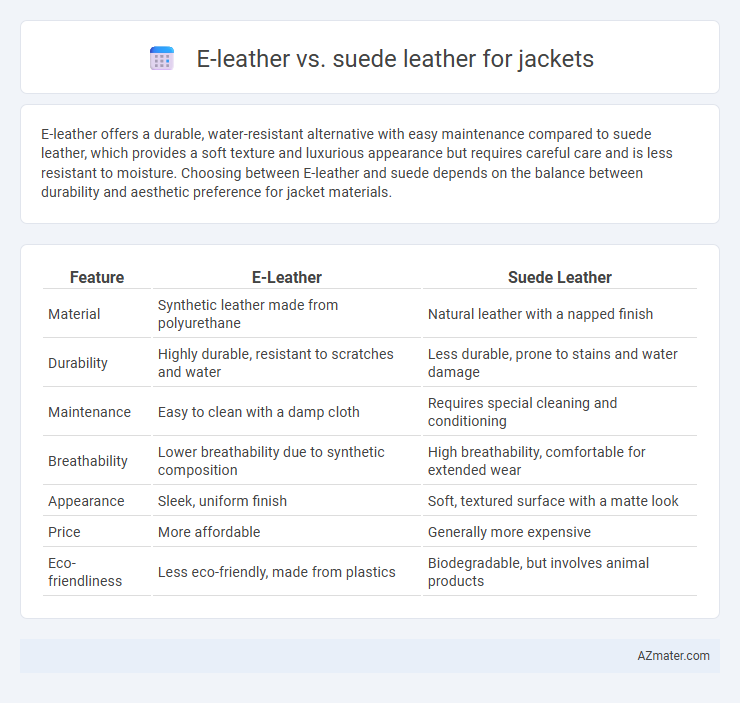E-leather offers a durable, water-resistant alternative with easy maintenance compared to suede leather, which provides a soft texture and luxurious appearance but requires careful care and is less resistant to moisture. Choosing between E-leather and suede depends on the balance between durability and aesthetic preference for jacket materials.
Table of Comparison
| Feature | E-Leather | Suede Leather |
|---|---|---|
| Material | Synthetic leather made from polyurethane | Natural leather with a napped finish |
| Durability | Highly durable, resistant to scratches and water | Less durable, prone to stains and water damage |
| Maintenance | Easy to clean with a damp cloth | Requires special cleaning and conditioning |
| Breathability | Lower breathability due to synthetic composition | High breathability, comfortable for extended wear |
| Appearance | Sleek, uniform finish | Soft, textured surface with a matte look |
| Price | More affordable | Generally more expensive |
| Eco-friendliness | Less eco-friendly, made from plastics | Biodegradable, but involves animal products |
Introduction to E-Leather and Suede Leather
E-leather, also known as eco-leather or synthetic leather, is made from polyurethane or microfiber, offering a cruelty-free alternative with water resistance and easy maintenance compared to traditional leather. Suede leather is produced from the underside of animal hides, characterized by its soft, napped surface that provides a luxurious texture but requires delicate care due to susceptibility to stains and moisture. Both materials are popular in jacket manufacturing, with E-leather favored for durability and ethical concerns, while suede is prized for its classic aesthetic and tactile appeal.
Material Composition and Manufacturing Process
E-leather is a synthetic material composed mainly of polyurethane or other plastic compounds layered on a fabric base, designed to mimic the appearance and durability of natural leather through advanced coating and embossing techniques. Suede leather, derived from the underside of animal hides, is characterized by its soft, napped finish achieved through specialized sanding and buffing processes that enhance breathability and flexibility. The manufacturing process of e-leather involves chemical treatments and machine fabrication for uniformity and water resistance, whereas suede requires careful natural hide selection and manual finishing to preserve its texture and strength.
Feel and Texture Comparison
E-leather offers a smooth and consistent texture with a sleek, polished feel, ideal for a modern, uniform look in jackets. Suede leather features a soft, napped surface with a plush, velvety texture that provides warmth and a luxurious tactile experience. The choice between e-leather and suede hinges on preference for the synthetic's durability and easy maintenance versus suede's natural softness and rich texture.
Durability and Longevity Differences
E-leather offers superior durability compared to suede leather due to its synthetic composition, resisting water, stains, and scratches more effectively. Suede leather, made from the underside of animal hides, is more delicate and prone to wear, requiring careful maintenance to preserve its texture and appearance. Over time, e-leather jackets tend to maintain their look and structural integrity longer than suede jackets, making them a more practical choice for extended use.
Comfort and Breathability Factors
E-leather jackets offer enhanced water resistance and durability but generally lack the breathability and softness found in suede leather, making them less comfortable for extended wear in warmer conditions. Suede leather provides superior breathability and a plush texture, allowing better airflow and moisture absorption, which enhances comfort during prolonged use. For optimal comfort and ventilation in jackets, suede remains the preferred choice despite e-leather's advantage in maintenance and longevity.
Maintenance and Cleaning Requirements
E-leather jackets require minimal maintenance, as they are water-resistant and can be cleaned with a damp cloth, making them ideal for easy daily care. Suede leather jackets demand more careful upkeep, needing specialized suede brushes and cleaning solvents to remove stains without damaging the delicate texture. Regularly protecting suede with a water and stain repellent spray is essential to maintain its appearance and prolong jacket longevity.
Environmental Impact and Sustainability
E-leather, or eco-friendly leather alternatives, often use synthetic materials that reduce reliance on animal farming, leading to lower greenhouse gas emissions and less water consumption compared to traditional suede leather, which is derived from animal hides through chemically intensive tanning processes. Suede leather production typically involves toxic chromium-based tanning that poses significant environmental hazards, affecting soil and water quality, whereas many e-leather options use plant-based or recycled components, enhancing sustainability. Choosing e-leather jackets contributes to reduced deforestation and animal cruelty, aligning better with eco-conscious fashion trends and circular economy principles.
Style and Aesthetic Appeal
E-leather jackets offer a sleek, modern aesthetic with a smooth, consistent texture that mimics genuine leather while providing durability and easy maintenance. Suede leather jackets deliver a soft, matte finish with a supple feel, creating a vintage, luxurious look favored in casual and sophisticated fashion styles. The choice between e-leather and suede hinges on desired style: contemporary, edgy appeal versus classic, textured elegance.
Cost and Value Analysis
E-leather jackets typically offer a more budget-friendly option compared to suede leather, with prices generally 30-50% lower due to synthetic manufacturing processes. Suede leather, made from the underside of animal hides, commands higher prices because of its durability, breathability, and luxury appeal, often resulting in greater long-term value despite the upfront cost. Consumers seeking cost-efficiency may prefer e-leather for its affordability and ease of maintenance, while suede remains ideal for those prioritizing natural texture and premium quality.
Choosing the Right Leather for Your Jacket
E-leather, made from durable synthetic materials with a smooth, water-resistant surface, offers easy maintenance and modern aesthetics ideal for versatile jacket wear. Suede leather provides a soft, textured feel with a luxurious appearance but requires careful care to avoid stains and water damage, making it suitable for more delicate, style-focused jackets. Selecting between E-leather and suede depends on balancing factors like durability, maintenance, weather resistance, and desired texture for your jacket's specific use.

Infographic: E-leather vs Suede leather for Jacket
 azmater.com
azmater.com